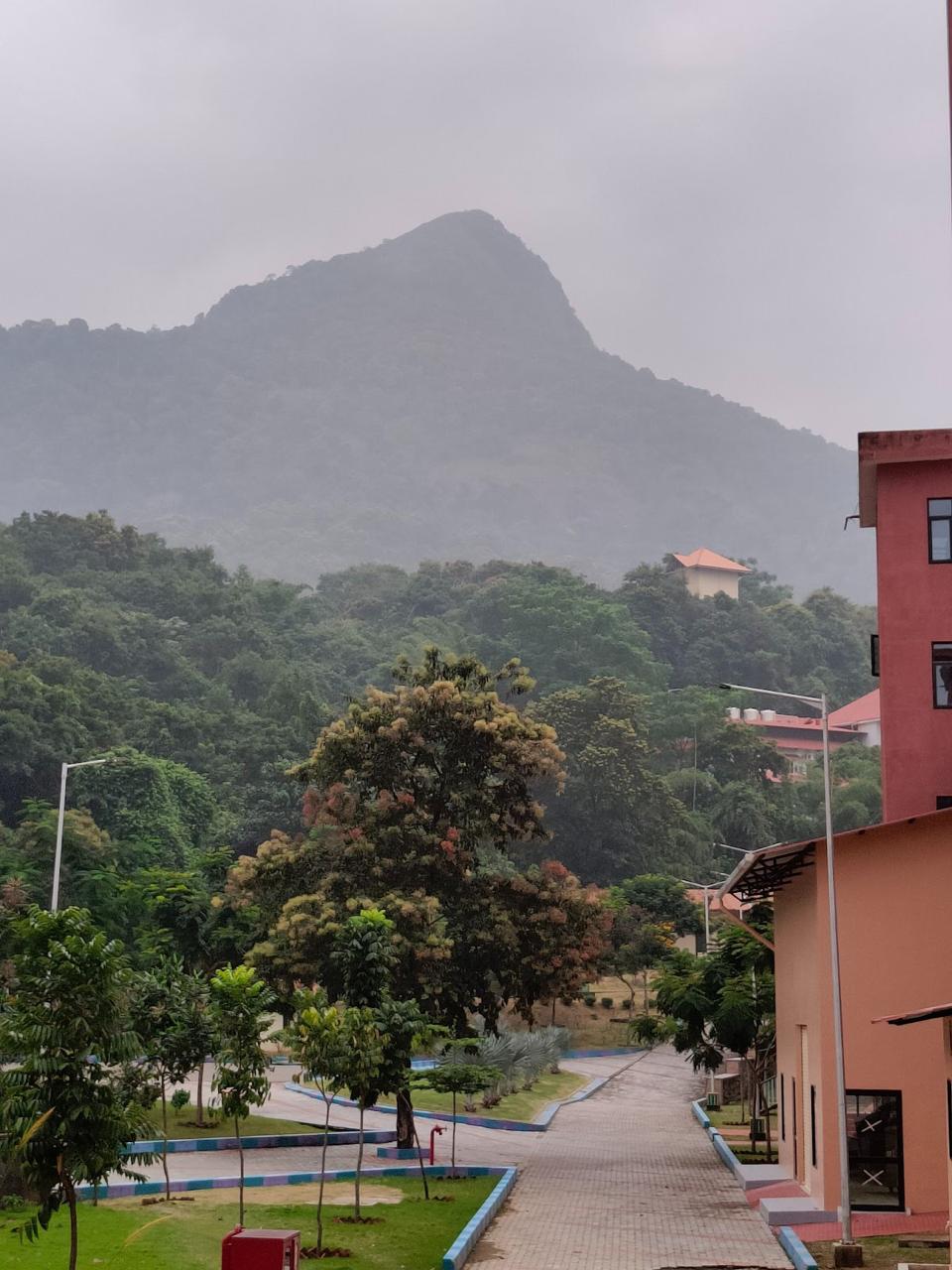
Terminalia paniculata has been my favourite tree ever since I came to this campus (mainly because this was literally the only tree I could ever name, especially the scientific name).
We would go birding very often, or I would notice a bird walk message in the Ecology Club group more often because I had just learnt the names of birds found around the campus and could finally tell a sparrow and swallow differently. Those sessions would still not come very easy because Smriti would tell me that a Flame-throated Bulbul is sitting right on the naked perch of that Terminalia tree. I pretended I knew and nodded as if I had located the bird, and everybody would just move on.
Long after struggling with being unable to tell trees (or rather not making an attempt to tell them), I asked Smriti which one was the Terminalia. To which, without making fun of me, she answered, (the one with white flowers with another red floral inflorescence on the top of the white ones). I nodded again. I kind-of knew what she meant, but being new to Ecology and the terminology, I was unfamiliar. However, with a bit of Google’s help, I could spot that Flame-throated Bulbul, which was no longer there, but at least I now knew which one was Terminalia, the one with white and red flowers.

A tree with just the flowers
I went home for vacation. To my surprise, all the Terminalia were gone* when I came back. I was bothered for a few days before plant blindness took over me, and I got burdened with academia again for months. I only knew that Terminalia was my favourite tree, and I would tell this to my friends, too. That was a semester without seeing a single individual of my favourite tree species.
It was time for another vacation (we have many of them, heh). And this time, the one-year-old ecologist in me was going for an internship in Bengaluru with this big hornbill person, Aparajita Datta, who had a PhD student, Bibi, doing a mammal seed dispersal project. I found myself at NCF to do a plant-centric literature review on fruit traits. I know nothing about plants except my favourite tree flowers once a year with twice as many coloured flowers. Spending two months in Bangalore was entirely worth it. I was now looking at all the natural elements with a different lens. I had more questions. I felt like I was getting into it, ecology. During my course there, I went for a couple of bird walks with Bibi and my lovely friend, Sayee and how beautifully both of them got me into watching trees. Now I had a new favourite tree, the rain tree. I started loving Rain Tree more after knowing why it is named so. There are numerous variations of this story, but the one I know goes like this: In the southern part of America, where this tree belongs rests a colossal colony of these cicadas (or some other insect; details are pretty foggy now). The massive Rain Tree Canopy and cicada poop made the locals believe that it is raining, and thus it was named so. Also, a canopy this big would save you from rain, so evidently and inescapably, it is called so. It is time to bid goodbye to Bangalore and my precious friends and return to Trivandrum. I now knew a handful of plant species, I learned how they classify and give names to biodiversity, I knew that some plants are more closely related than others, I knew that bryophytes are very old, and I was starting to learn the jargon. From a one-year-old ecologist, I was beginning to become somebody who would think of plants and animals naturally as a part of daily life.
I came back to Trivandrum, and again, it was time. It was the time. The campus was full of Terminalia again. It was all white, though. Smriti again told me I should wait for the red flowers to come on top of the white ones. A few days passed, and the flowers were still white. I noticed a message by Anuraag on the Ecology Group about another birding session, and of course, I had to go.
During the session, I, who can now lead the birding session, mentioned to these juniors about my favourite tree and how it will have red flowers soon enough, but I was interrupted by Vishwa. Vishwa, the ultimate plant person in my college, is still a go-to if I want to identify a plant.
Disappointed, Vishwa tells me that those red things on Terminalia are not its flowers but fruits! Oh lord, a new world opened up for me. And I was just- blown.

Same tree with flowers and fruits
With mid-sems approaching, I would go to the computer lab to study and used to only return by midnight. And every day, my friend Akhila and I would take the longest route possible so that we could see the fruitless and flowerful bright white Terminalia. Magical. Weeks pass, and no fruits.
The Ecology Club invited the SeasonWatch team to the science fest this year for a plant identification workshop. While talking to the team, I often told Sayee (who by now you know is a great friend of mine and is also a SeasonWatch person) that by the time they came here, Terminalia would have had a few fruits on it. And I was right. Terminalia began to fruit by late October, and now I knew much more about them. Sayee and Nizar, who were finally here while taking a walk, mentioned how horribly (in a good way) she was smelling the Terminalia. Still, not seeing a flower or a fruit up close saddened me because all the flowers are at least ten or more feet above the ground, and only a few leaves droop down to a six-foot level. But as they say, beginner luck worked out for me. This one day, again taking the longer route from this one section of the campus that gives the view of the beautiful landscape of Kurishumala Peak, I spotted another Terminalia, which had its flowers very close to my eye level. Only Avani and Riya, my classmates who were with me that day, would know how I ran to get a close-up look at those white, snowy inflorescence (I now knew what an inflorescence is without Google). I pluck one of them out, and Avani loses it. My joy of seeing a flower of my one-and-a-half-year-old favourite tree up so close doesn’t let me bother so much about it. It was like one of the million-tiny-passive dreams coming true. Oh, but wait, what is that moving on the flowers!? Oh gosh, it is a spider! A spider that matched its colour and size with that of the flowers. With many identification issues, I learned that it is a crab spider that also builds its web on the tree. And I wasn’t the only one who loved the flowers so much.
And how crazy is it to witness this beauty? It is surreal how I will have to wait another year to see the landscape painted in reds, whites and greens. And how horrible it is to wait another year for Smriti to tell me to look at the white and red flower tree for the flame-throated Bulbul. To those who go crazy about astronomical events that occur annually, please come for a bird walk with me so that I can tell you about my favourite tree.
Days passed to today. Kurishumala Peak landscape is full of blood red flowe—oops, fruits of Terminalia. I still have not realised another one of my million-tiny-passive dreams of having a close-up look at the fruit of Terminalia. Not all the flowers have turned into fruits. Many of the campus Terminalia are still full of whiteness with no- to very-few fruits. The nationalism in me just fed right by knowing that trees this beautiful are native to the Indian mainland.
Hopefully, that crab spider knows that the red ones are not flowers but fruits. With many more tree names and the ability to tell them without the flowers, the two-year-old ecologist in me still loves Terminalia the same.
P.S. – The Ecology Club is formally called the Ecological Society of IISER Thiruvananthapuram. I love you guys. And thanks very much to the people I have mentioned in this story, for without them, no story of mine is complete.
Thanks Rishika for sending (almost all) of these photos.
Footnote:
*They did not cut the Terminalia down but at that time I was unable to identify it without them bearing the fruits.
About the author: Aarul Jain is a Masters Student in Biology at IISER Thiruvananthapuram, hailing from Jaipur. Looking forward to making a career Ecology and Conservation, with a love for writing about the nitty-gritties of things we live around.





